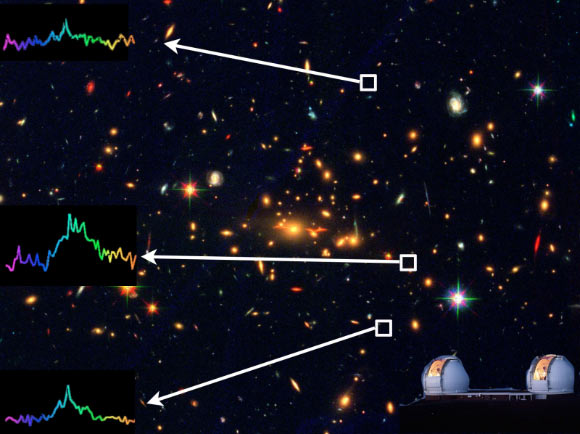Astronomers have detected and confirmed the faintest early-Universe galaxy ever using the 10-m Keck II telescope at the W. M. Keck Observatory, Hawaii.

Color image of MACS J2129.4-0741 taken with the NASA/ESA Hubble Space Telescope: an image of the faint, distant galaxy was split into three by a powerful gravitational lens; by comparing the spectra of the three images (white boxes), astronomers could show they were all the same object 13 billion light-years away. Image credit: Marusa Bradac / Hubble Space Telescope / W. M. Keck Observatory.
The scientists, led by Dr. Kuang-Han Huang from the University of California, Davis, saw the galaxy as it was 13 billion years ago.
The detection was made possible through a phenomenon predicted by Albert Einstein in which an object is magnified by the gravity of another object that is between it and the viewer.
In this case, the newfound galaxy was behind a massive cluster of galaxies called MACS J2129.4-0741.
Dr. Huang and co-authors were able to show that the three images were of the same galaxy because they showed similar spectra.
“If the light from this galaxy was not magnified by factors of 11, 5 and 2, we would not have been able to see it,” Dr. Huang said.
“It lies near the end of the Epoch of Reionization, during which most of the hydrogen gas between galaxies transitioned from being mostly neutral to being mostly ionized and lit up the stars for the first time. That shows how gravitational lensing is important for understanding the faint galaxy population that dominates the reionization photon production.”
“We now have good constraints on when the reionization process ends – at redshift around 6, or 12.5 billion years ago – but we don’t yet know a lot of details about how it happened,” he added.
“This galaxy is exciting because the team infers a very low stellar mass, or only one percent of one percent of the Milky Way Galaxy,” said Keck Observatory astronomer Dr. Marc Kassis.
“It’s a very, very small galaxy and at such a great distance, it’s a clue in answering one of the fundamental questions astronomy is trying to understand: what is causing the hydrogen gas at the very beginning of the Universe to go from neutral to ionized about 13 billion years ago. That’s when stars turned on and matter became more complex.”
The findings were published this week in the Astrophysical Journal Letters (arXiv.org preprint).
_____
Kuang-Han Huang et al. 2016. Detection of Lyman-Alpha Emission from a Triply Imaged z = 6.85 Galaxy behind MACS J2129.4-0741. ApJ 823, L14; doi: 10.3847/2041-8205/823/1/L14







